
English Encyclopedia
 Important port
Important port
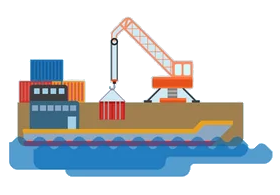
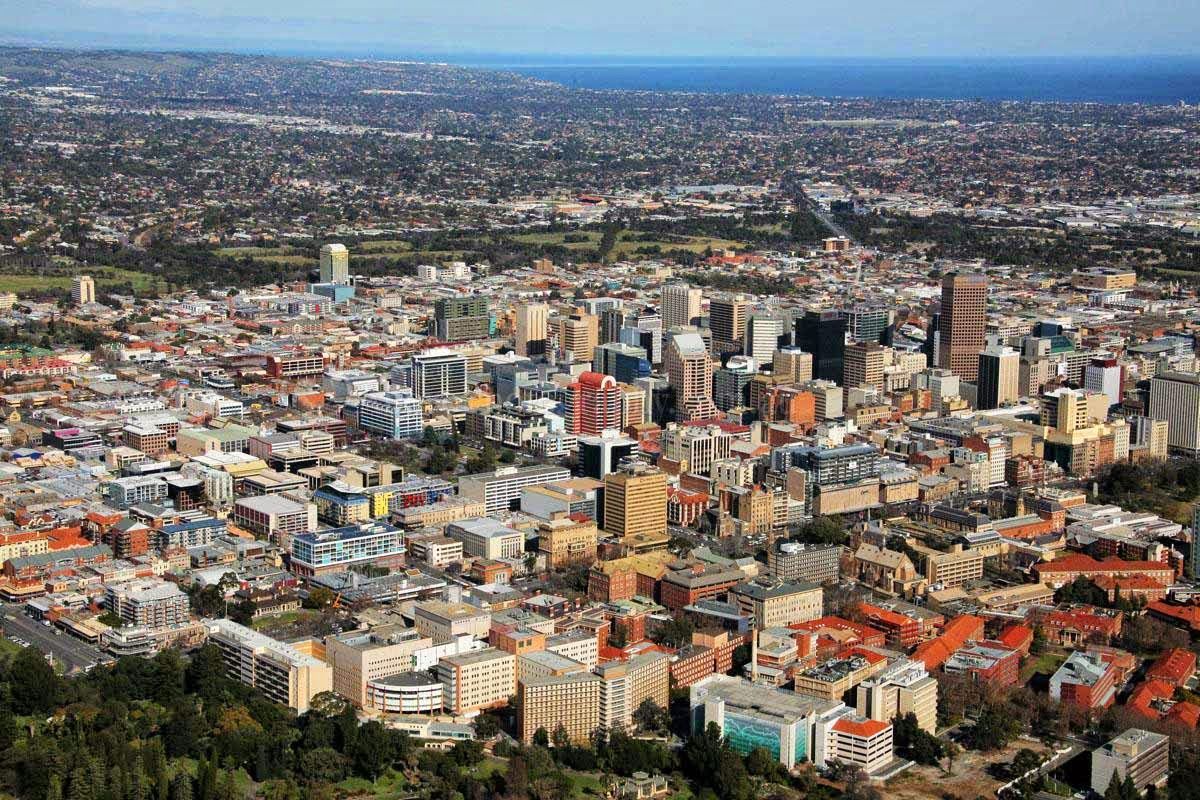
Adelaide [ˈædəleɪd] ist die Hauptstadt des Bundesstaates South Australia in Australien. Adelaide ist eine Küstenstadt am Saint-Vincent-Golf und wurde vom ersten Gouverneur des Staates, Captain John Hindmarsh (1785–1860), 1837 nach der britischen Königin Adelaide (Adelheid von Sachsen-Meiningen) benannt. Adelaide ging im Gegensatz zu Städten wie Sydney oder Hobart nicht aus einer Sträflingskolonie hervor.
Die Stadt trägt wegen ihrer Kulturveranstaltungen den Beinamen „festival city“, so etwa das Glenelg Jazz Festival oder das Adelaide Festival of Arts. Ebenso wird Adelaide „city of churches“ (Stadt der Kirchen) genannt. Adelaide ist Austragungsort mehrerer sportlicher Veranstaltungen, so z. B. von 1985 bis 1995 des Großen Preises von Australien der Formel 1 auf dem Adelaide Street Circuit.
Die Stadt Adelaide besteht eigentlich nur aus dem Stadtkern innerhalb des Parkrings, unterteilt in Adelaide und North Adelaide. Sie hat 22.000 Einwohner.[2][3] Man rechnet jedoch die direkt umliegenden etwa 250 Orte zum städtischen Bereich hinzu.
In einer Rangliste der Städte nach ihrer Lebensqualität belegte Adelaide im Jahre 2018 den 29. Platz unter 231 untersuchten Städten weltweit.
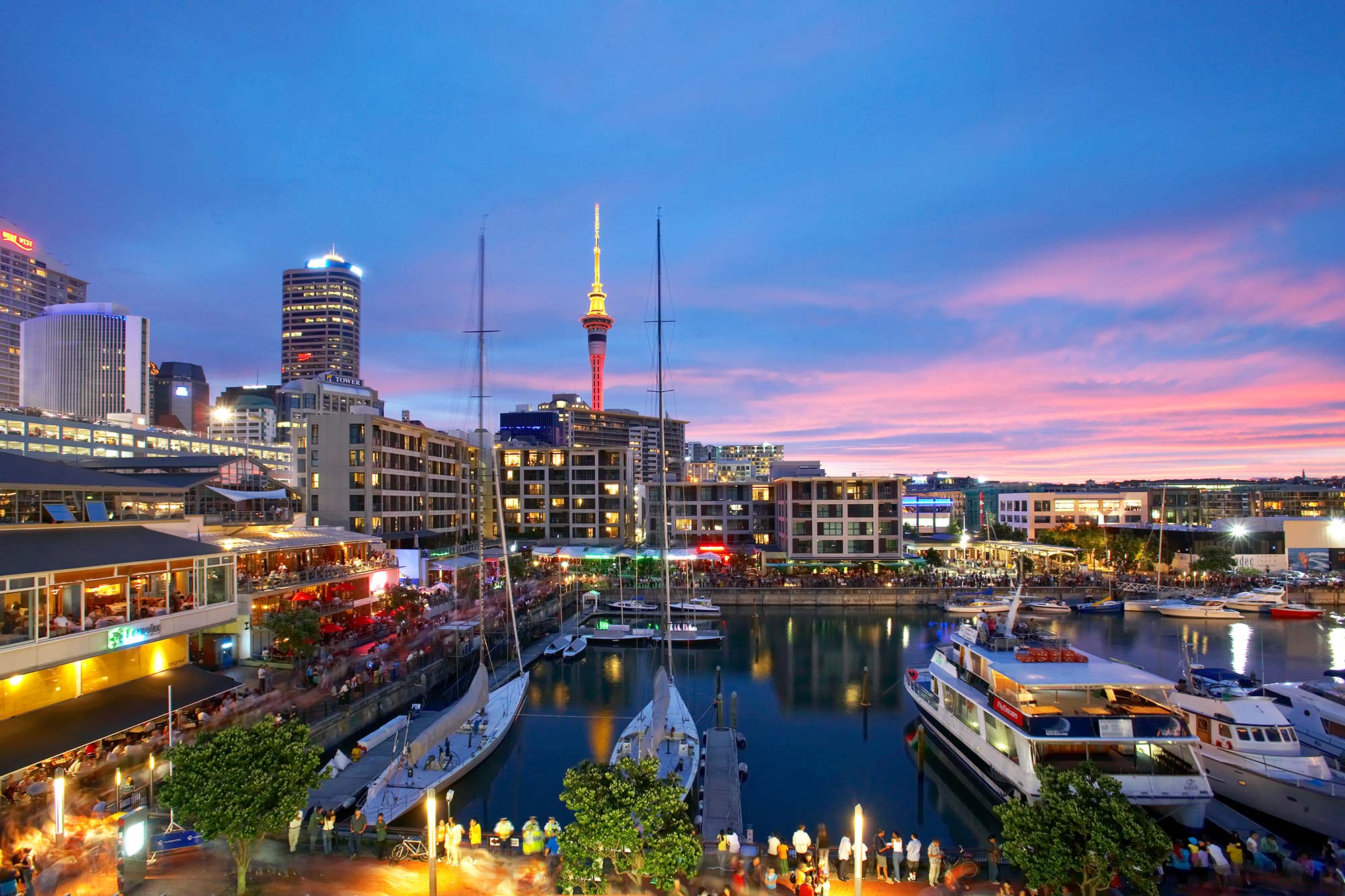
Auckland (Māori: Tāmaki Makaurau) is a large metropolitan city in the North Island of New Zealand. The most populous urban area in the country, Auckland has an urban population of about 1,463,000 (June 2021).[4] It is located in the Auckland Region—the area governed by Auckland Council—which includes outlying rural areas and the islands of the Hauraki Gulf, and which has a total population of 1,715,600.[4] While Europeans continue to make up the plurality of Auckland's population, the city became multicultural and cosmopolitan in the late-20th century, with Asians accounting for 31% of the city's population in 2018.[6] Auckland is also home to the largest Polynesian population in the world.[7] The Māori-language name for Auckland is Tāmaki Makaurau, meaning "Tāmaki desired by many", in reference to the desirability of its natural resources and geography.[8]
Auckland lies between the Hauraki Gulf to the east, the Hunua Ranges to the south-east, the Manukau Harbour to the south-west, and the Waitākere Ranges and smaller ranges to the west and north-west. The surrounding hills are covered in rainforest and the landscape is dotted with 53 volcanic centres that make up the Auckland Volcanic Field. The central part of the urban area occupies a narrow isthmus between the Manukau Harbour on the Tasman Sea and the Waitematā Harbour on the Pacific Ocean. Auckland is one of the few cities in the world to have a harbour on each of two separate major bodies of water.
The isthmus on which Auckland sits was first settled c. 1350 and was valued for its rich and fertile land. The Māori population in the area is estimated to have peaked at 20,000 before the arrival of Europeans.[9] After a British colony was established in New Zealand in 1840, William Hobson, then Lieutenant-Governor of New Zealand, chose Auckland as its new capital. He named the area for George Eden, Earl of Auckland, British First Lord of the Admiralty. Māori–European conflict over land in the region led to war in the mid-19th century. In 1865, Auckland was replaced by Wellington as the capital, but continued to grow, initially because of its port and the logging and gold-mining activities in its hinterland, and later because of pastoral farming (especially dairy farming) in the surrounding area, and manufacturing in the city itself.[10] It has been the nation's largest city throughout most of its history. Today, Auckland's central business district is New Zealand's leading economic hub.
The University of Auckland, founded in 1883, is the largest university in New Zealand. The city's significant tourist attractions include national historic sites, festivals, performing arts, sports activities, and a variety of cultural institutions, such as the Auckland War Memorial Museum, the Museum of Transport and Technology, and the Auckland Art Gallery Toi o Tāmaki. Its architectural landmarks include the Harbour Bridge, the Town Hall, the Ferry Building and the Sky Tower. The city is served by Auckland Airport, which handles around 2 million international passengers a month. Despite being one of the most expensive cities in the world,[11] Auckland is recognised as one of the world's most liveable cities, ranking third in the 2019 Mercer Quality of Living Survey and at first place in a 2021 ranking of the global liveability index by The Economist.

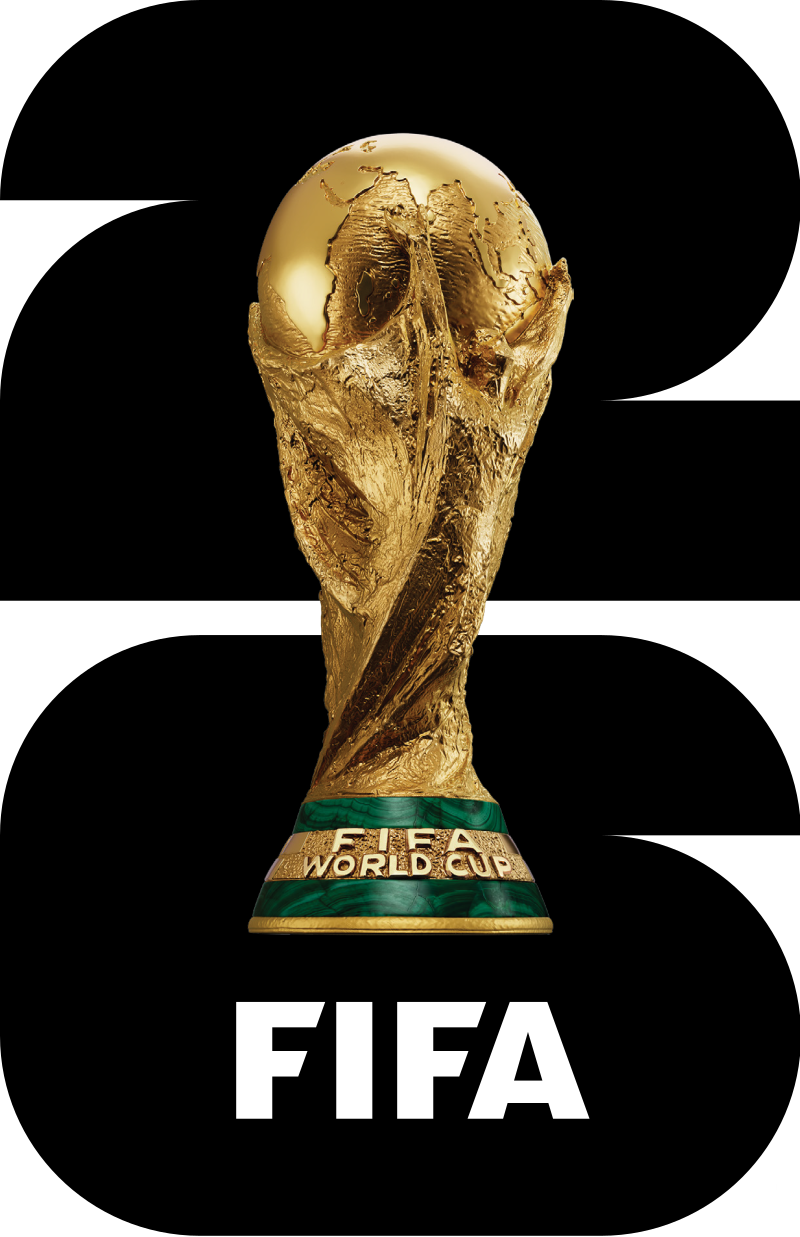 FIFA Fussball-Weltmeisterschaft 2026
FIFA Fussball-Weltmeisterschaft 2026

 Financial
Financial
 ***Global Financial Center
***Global Financial Center

 History
History
 N 2000 - 2100 AD
N 2000 - 2100 AD

 History
History
 M 1500 - 2000 AD
M 1500 - 2000 AD

 International cities
International cities
 ***Global Urban Economic Competitiveness
***Global Urban Economic Competitiveness

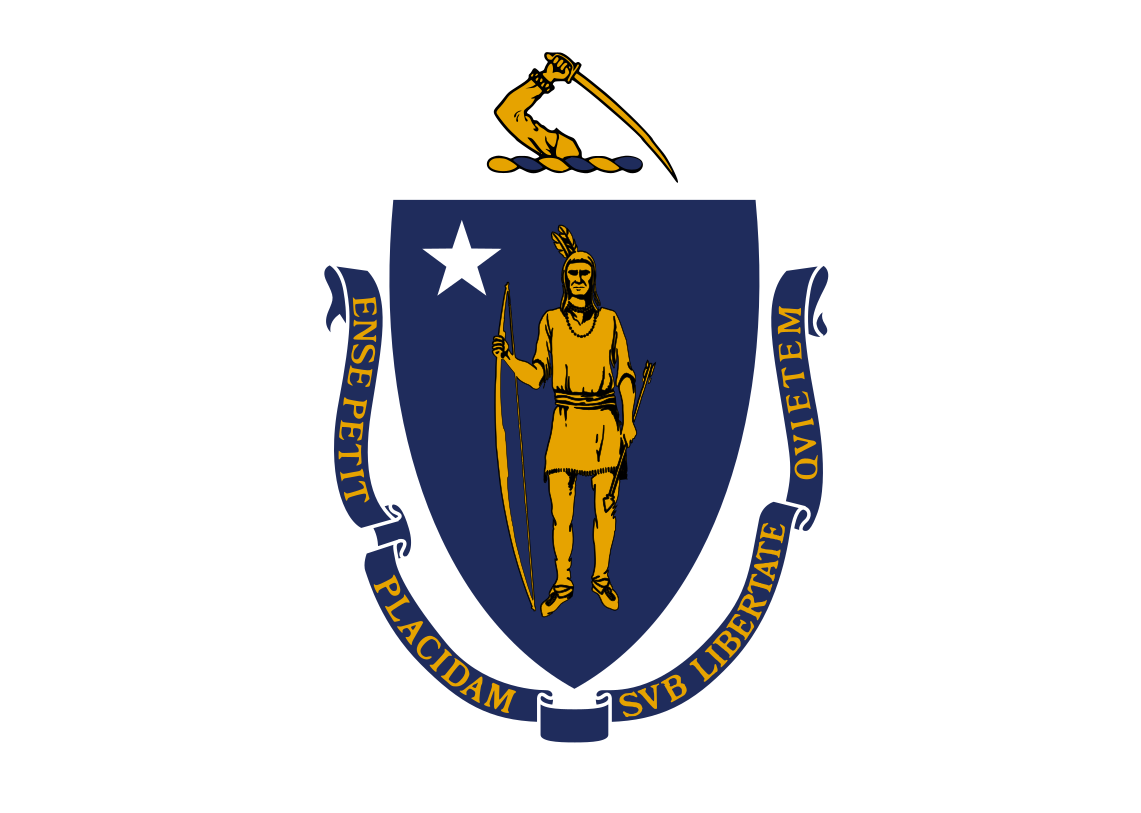 Massachusetts-MA
Massachusetts-MA


 Important port
Important port
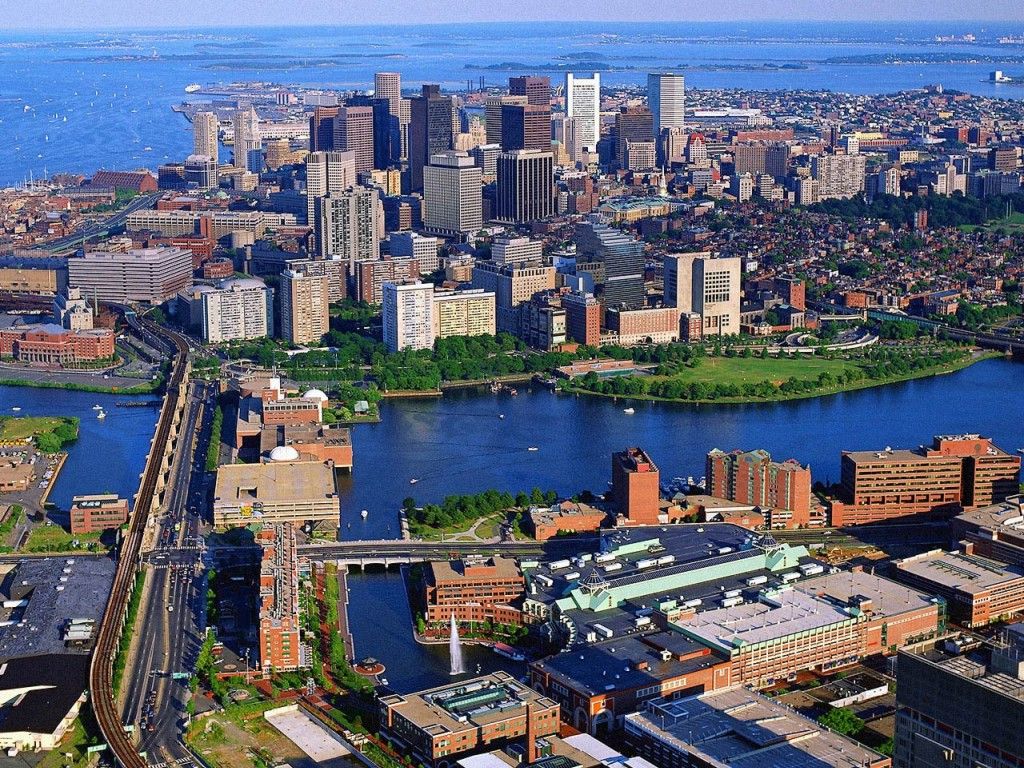
Boston (US: /ˈbɔːstən/, UK: /ˈbɒstən/),[5] officially the City of Boston, is the capital and most populous city of the Commonwealth of Massachusetts in the United States and 24th-most populous city in the country.[6] The city proper covers 48.4 square miles (125 km2)[7] with a population of 675,647 in 2020,[2] also making it the most populous city in New England.[8] It is the seat of Suffolk County (although the county government was disbanded on July 1, 1999).[9] The city is the economic and cultural anchor of a substantially larger metropolitan area known as Greater Boston, a metropolitan statistical area (MSA) home to a census-estimated 4.8 million people in 2016 and ranking as the tenth-largest MSA in the country.[10] A broader combined statistical area (CSA), generally corresponding to the commuting area[11] and including Providence, Rhode Island, is home to some 8.2 million people, making it the sixth most populous in the United States.[12]
Boston is one of the oldest municipalities in the United States, founded on the Shawmut Peninsula in 1630 by Puritan settlers from the English town of the same name.[13][14] It was the scene of several key events of the American Revolution, such as the Boston Massacre, the Boston Tea Party, the Battle of Bunker Hill and the siege of Boston. Upon American independence from Great Britain, the city continued to be an important port and manufacturing hub as well as a center for education and culture.[15][16] The city has expanded beyond the original peninsula through land reclamation and municipal annexation. Its rich history attracts many tourists, with Faneuil Hall alone drawing more than 20 million visitors per year.[17] Boston's many firsts include the United States' first public park (Boston Common, 1634), first public or state school (Boston Latin School, 1635)[18] and first subway system (Tremont Street subway, 1897).[19]
Today, Boston is a thriving center of scientific research. The Boston area's many colleges and universities make it a world leader in higher education,[20] including law, medicine, engineering and business, and the city is considered to be a global pioneer in innovation and entrepreneurship, with nearly 5,000 startups.[21][22][23] Boston's economic base also includes finance,[24] professional and business services, biotechnology, information technology and government activities.[25] Households in the city claim the highest average rate of philanthropy in the United States;[26] businesses and institutions rank among the top in the country for environmental sustainability and investment.[27] The city has one of the highest costs of living in the United States[28][29] as it has undergone gentrification.[
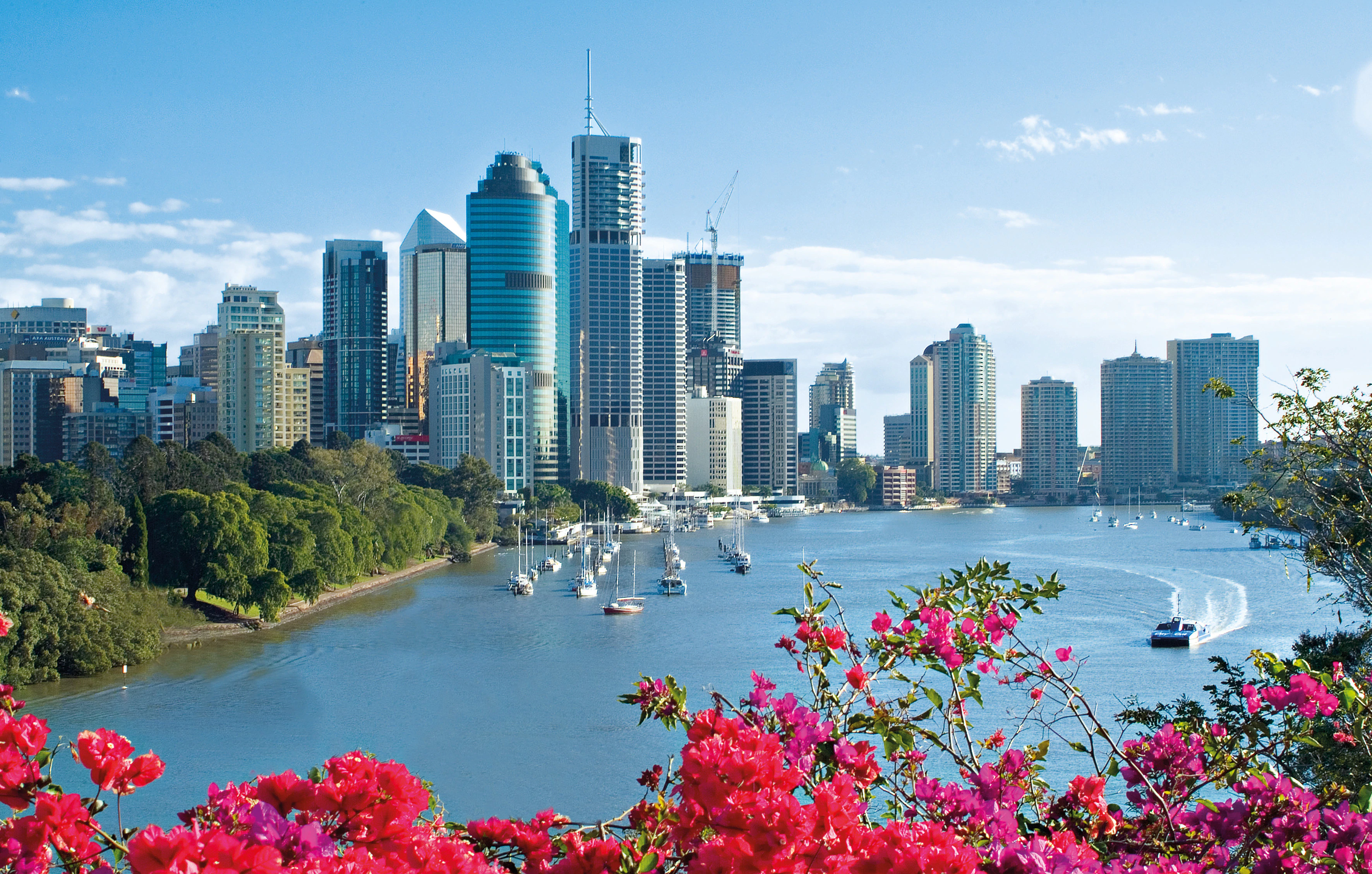
Brisbane (/ˈbrɪzbən/ ( listen) BRIZ-bən[9]) is the capital and most populous city of the Australian state of Queensland,[10] and the third-most populous city in Australia, as well as Oceania. Brisbane's metropolitan area has a population of around 2.6 million,[11] and it lies at the centre of the South East Queensland metropolitan region, which encompasses a population of around 3.8 million.[12] The Brisbane central business district is situated within a peninsula of the Brisbane River about 15 km (9 mi) from its mouth at Moreton Bay, a bay of the Coral Sea.[13] Geographically Australia's largest metropolitan area, Brisbane extends in all directions along the hilly floodplain of the Brisbane River Valley between Moreton Bay and the Taylor and D'Aguilar mountain ranges.[14] It sprawls across several of Australia's most populous local government areas, most centrally the City of Brisbane, Australia's most populous local government area. The demonym of Brisbane is "Brisbanite".[15][16]
listen) BRIZ-bən[9]) is the capital and most populous city of the Australian state of Queensland,[10] and the third-most populous city in Australia, as well as Oceania. Brisbane's metropolitan area has a population of around 2.6 million,[11] and it lies at the centre of the South East Queensland metropolitan region, which encompasses a population of around 3.8 million.[12] The Brisbane central business district is situated within a peninsula of the Brisbane River about 15 km (9 mi) from its mouth at Moreton Bay, a bay of the Coral Sea.[13] Geographically Australia's largest metropolitan area, Brisbane extends in all directions along the hilly floodplain of the Brisbane River Valley between Moreton Bay and the Taylor and D'Aguilar mountain ranges.[14] It sprawls across several of Australia's most populous local government areas, most centrally the City of Brisbane, Australia's most populous local government area. The demonym of Brisbane is "Brisbanite".[15][16]
The city and the river are named after Sir Thomas Brisbane who was the governor of New South Wales when the city was founded.[10] The Moreton Bay penal settlement was founded in 1824 at Redcliffe as a place for secondary offenders from the Sydney colony, and soon moved to North Quay in 1825. Brisbane was chosen as Queensland's capital when Queensland separated from New South Wales in 1859. By the late 19th century, the city had grown into a major port and centre of immigration. During World War II, the Allied command in the South West Pacific was based in the city, along with the headquarters for General Douglas MacArthur of the United States Army.[17]
Brisbane is classified as a global city,[18][19] and is an advanced centre of research and innovation in the Asia-Pacific.[20] The city has strengths in technology,[21][22] including mining research and green energy,[23] medicine and biotechnology,[24][25] cryptocurrency and digital industries,[26] and robotics.[27] A transport hub, Brisbane is served by large rail, bus and ferry networks, as well as Australia's largest airport and third-largest seaport.
A diverse city with over 32% of its metropolitan population being foreign-born,[28] Brisbane is consistently ranked among the world's most livable cities.[29] The culture of Brisbane is noted in particular for Queenslander architecture, spring Jacaranda blossoms, and its outdoor dining culture. Brisbane has hosted major events including the 1982 Commonwealth Games, World Expo 88, the 2014 G20 summit, and will host the 2032 Summer Olympics and Paralympics.[30]
Brisbane is a popular tourist destination. Major landmarks and attractions include South Bank Parklands, the Queensland Art Gallery and Gallery of Modern Art, the City Botanic Gardens, City Hall, the Story Bridge, the Mount Coot-tha Botanic Gardens and Lookout, Lone Pine Koala Sanctuary, Howard Smith Wharves, New Farm Park, D'Aguilar National Park, and Moreton Bay and its islands, including Moreton, North Stradbroke and St Helena.
 FIFA Fussball-Weltmeisterschaft 2010
FIFA Fussball-Weltmeisterschaft 2010

 International cities
International cities
 *World Design Capital
*World Design Capital
 Silk road
Silk road

 Sport
Sport
 The Ocean Race
The Ocean Race
 South Africa
South Africa

 Important port
Important port
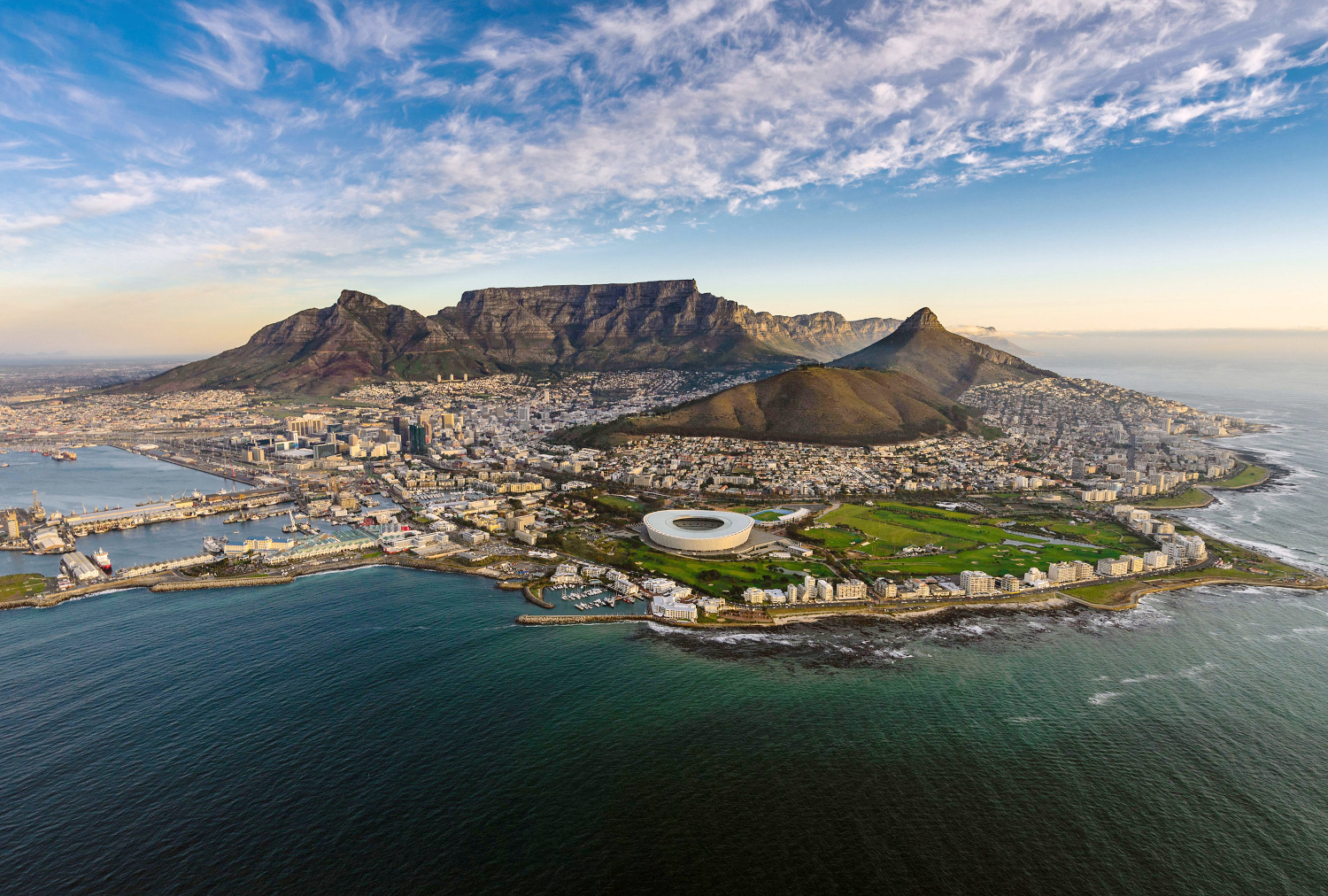
Cape Town (Afrikaans: Kaapstad [ˈkɑːpstat]; Xhosa: iKapa; Dutch: Kaapstad; South Sotho: Motse Kapa) is the oldest city in South Africa, colloquially named the Mother City. It is the legislative capital of South Africa and primate city of the Western Cape province.[7] It forms part of the City of Cape Town metropolitan municipality.
The Parliament of South Africa sits in Cape Town.[8] The other two capitals are located in Pretoria (the administrative capital where the Presidency is based) and Bloemfontein (the judicial capital where the Supreme Court of Appeal is located).[9] The city is known for its harbour, for its natural setting in the Cape Floristic Region, and for landmarks such as Table Mountain and Cape Point. Cape Town is home to 64% of the Western Cape's population.[10] It is one of the most multicultural cities in the world, reflecting its role as a major destination for immigrants and expatriates to South Africa.[11] The city was named the World Design Capital for 2014 by the International Council of Societies of Industrial Design.[12] In 2014, Cape Town was named the best place in the world to visit by both The New York Times[13] and The Daily Telegraph.[14]
Located on the shore of Table Bay, Cape Town, as the oldest urban area in South Africa, was developed by the Dutch East India Company (VOC) as a supply station for Dutch ships sailing to East Africa, India, and the Far East. Jan van Riebeeck's arrival on 6 April 1652 established Dutch Cape Colony, the first permanent European settlement in South Africa. Cape Town outgrew its original purpose as the first European outpost at the Castle of Good Hope, becoming the economic and cultural hub of the Cape Colony. Until the Witwatersrand Gold Rush and the development of Johannesburg, Cape Town was the largest city in South Africa.
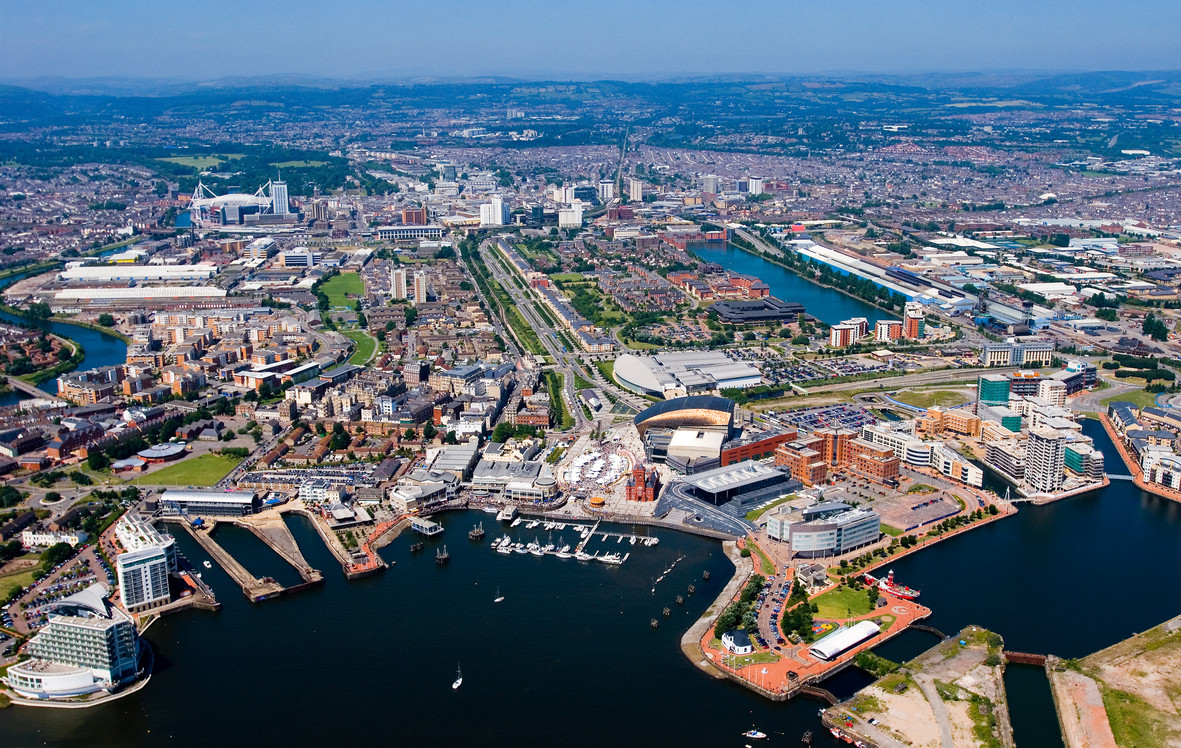
Cardiff (/ˈkɑːrdɪf/ ( listen); Welsh: Caerdydd [kairˈdiːð, kɑːɨrˈdɨːð] (
listen); Welsh: Caerdydd [kairˈdiːð, kɑːɨrˈdɨːð] ( listen)) is the capital of, and largest city in, Wales, and the eleventh-largest city in the United Kingdom. It is Wales's chief commercial centre, the base for most national cultural and sporting institutions, the Welsh national media, and the seat of the National Assembly for Wales. The unitary authority area's 2017 population was estimated to be 362,756.[1] Cardiff is a significant tourist centre and the most popular visitor destination in Wales with 21.3 million visitors in 2017.[5] In 2011, Cardiff was ranked sixth in the world in National Geographic's alternative tourist destinations.[6]
listen)) is the capital of, and largest city in, Wales, and the eleventh-largest city in the United Kingdom. It is Wales's chief commercial centre, the base for most national cultural and sporting institutions, the Welsh national media, and the seat of the National Assembly for Wales. The unitary authority area's 2017 population was estimated to be 362,756.[1] Cardiff is a significant tourist centre and the most popular visitor destination in Wales with 21.3 million visitors in 2017.[5] In 2011, Cardiff was ranked sixth in the world in National Geographic's alternative tourist destinations.[6]
Cardiff is the county town of the historic county of Glamorgan (and later South Glamorgan). Cardiff is part of the Eurocities network of the largest European cities.[7] A small town until the early 19th century, its prominence as a major port for the transport of coal following the arrival of industry in the region contributed to its rise as a major city. The Cardiff Built-up Area covers a slightly larger area outside the county boundary and includes the towns of Dinas Powys and Penarth. In 1905, Cardiff was made a city and proclaimed the capital of Wales in 1955.
Since the 1980s, Cardiff has seen significant development. A new waterfront area at Cardiff Bay contains the Senedd building, home to the Welsh Assembly and the Wales Millennium Centre arts complex. Current developments include the continuation of the redevelopment of the Cardiff Bay and city centre areas with projects such as the Cardiff International Sports Village, a BBC drama village,[8] and a new business district in the city centre.[9] Sporting venues in the city include the Principality Stadium—the national stadium and the home of the Wales national rugby union team—Sophia Gardens (the home of Glamorgan County Cricket Club), Cardiff City Stadium (the home of Cardiff City football team and the Wales football team), Cardiff International Sports Stadium (the home of Cardiff Amateur Athletic Club), Cardiff Arms Park (the home of Cardiff Blues and Cardiff RFC rugby union teams) and Ice Arena Wales (the home of Cardiff Devils ice hockey team). The city hosted the 1958 British Empire and Commonwealth Games. The city was awarded the title of European City of Sport twice, due to its role in hosting major international sporting events: first in 2009 and again in 2014.[10] The Principality Stadium hosted 11 football matches as part of the 2012 Summer Olympics, including the games' opening event and the men's bronze medal match.
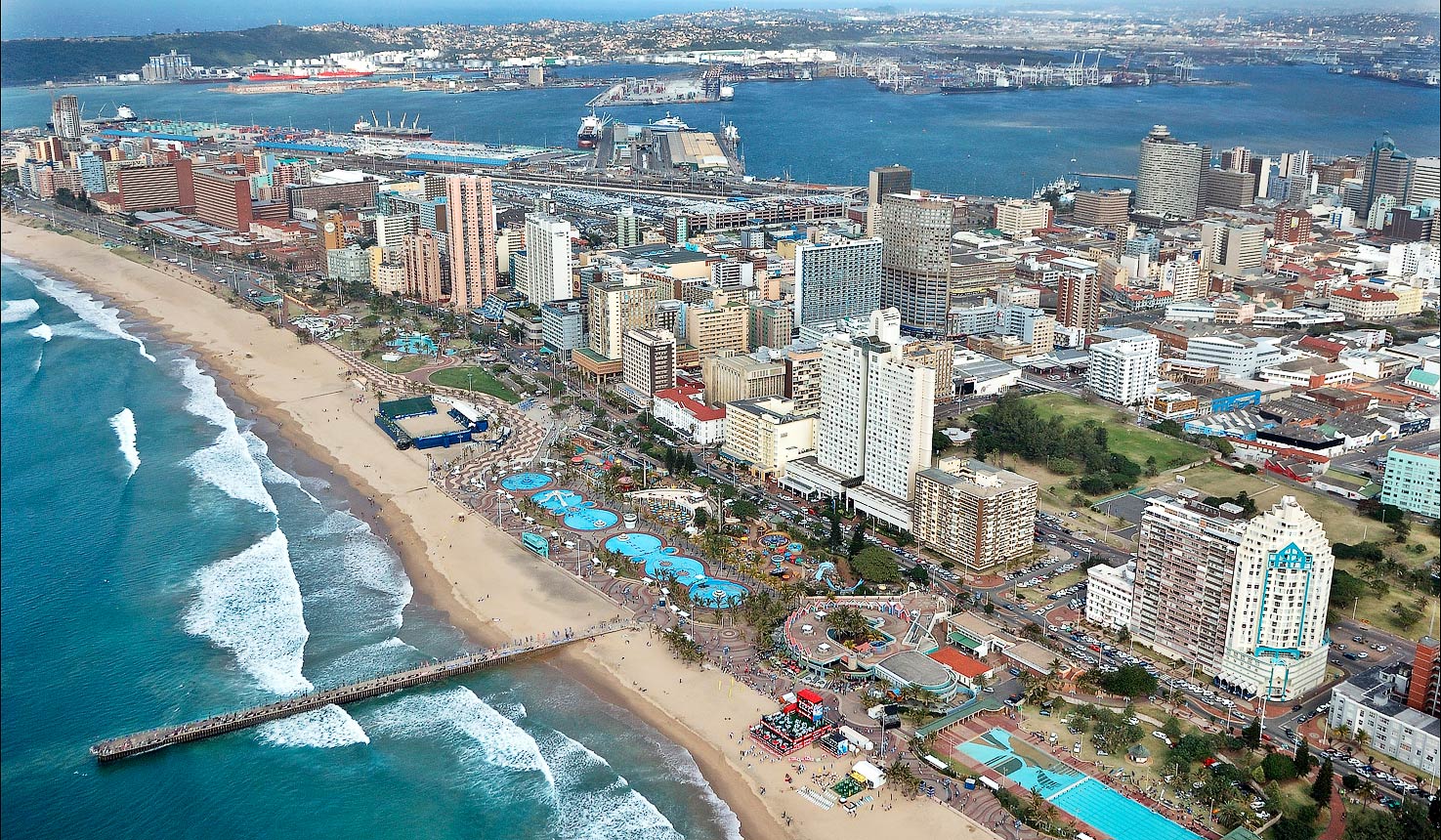
Durban (/ˈdɜːrbən/ DUR-bən) (Zulu: eThekwini, from itheku meaning 'the port'), nicknamed Durbs,[7][8] is the third most populous city in South Africa after Johannesburg and Cape Town and the largest city in the South African province of KwaZulu-Natal. Durban forms part of the eThekwini Metropolitan Municipality, which includes neighbouring towns and has a population of about 3.44 million,[9] making the combined municipality one of the largest cities on the Indian Ocean coast of the African continent. Durban was one of the host cities of the 2010 FIFA World Cup.
Durban was formerly named Port Natal due to its position as the chief seaport of South Africa, and its location on the Natal Bay of the Indian Ocean.[10] Durban is an ethnically diverse city, with large Zulu, British, and Indian populations.
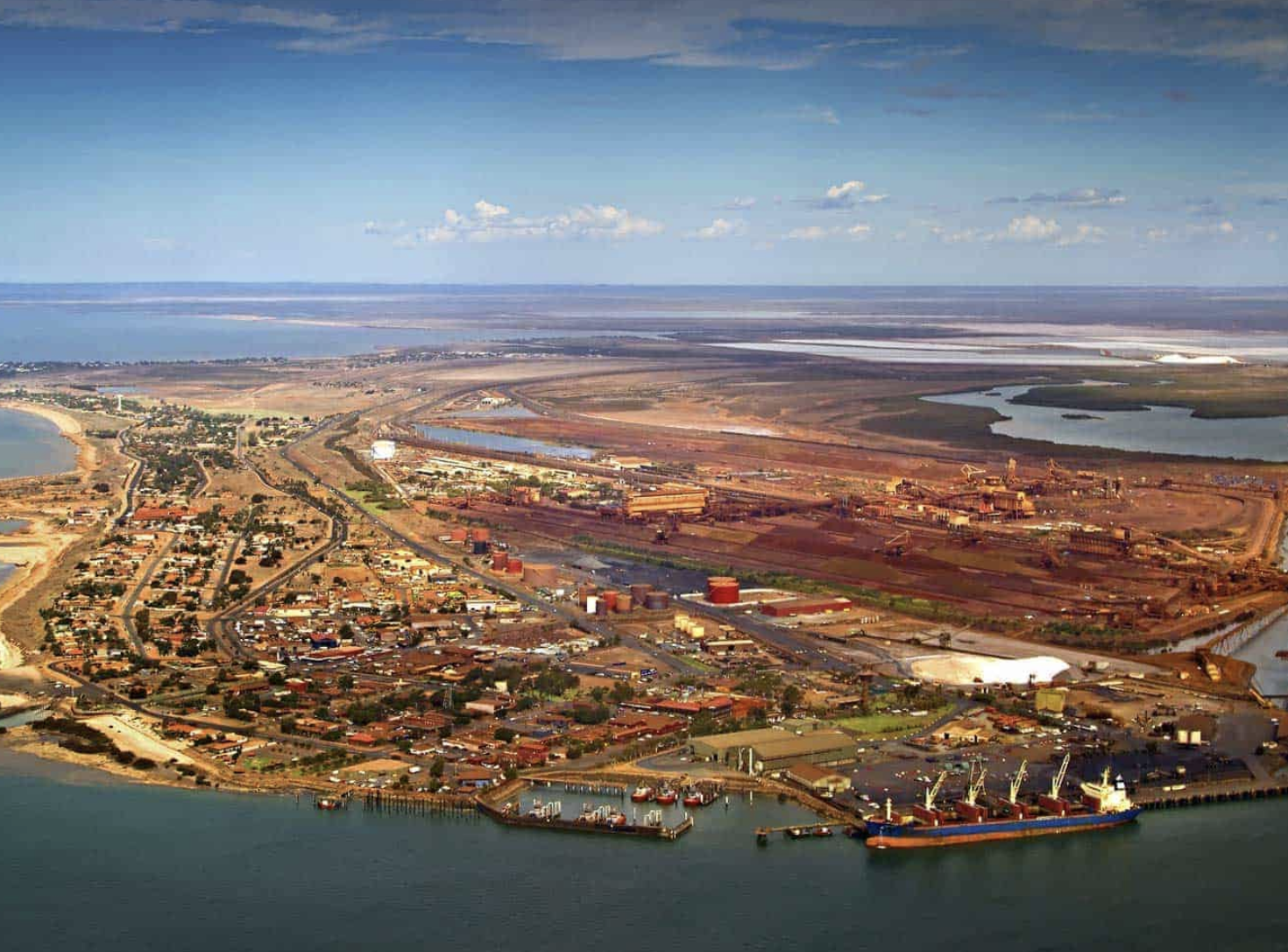
Port Hedland (Kariyarra: Marapikurrinya) is the second largest town[2] in the Pilbara region of Western Australia, with an urban population of 14,320[1] at June 2018 including the satellite town of South Hedland, 18 kilometres (11 mi) away. It is also the site of the highest tonnage port in Australia.[3]
Port Hedland has a natural deep anchorage harbour which, as well as being the main fuel and container receival point for the region, was seen as perfect for shipment of the iron ore being mined in the ranges located inland from the town. The ore is moved by railway from four major iron ore deposits to the east and south of the Port Hedland area. The port exported 519,408,000 tonnes (1.1 trillion pounds) of iron ore (2017–2018).[4] Other major resource activities supported by the town include the offshore natural gas fields, salt, manganese, and livestock. Major deposits of lithium are being developed and exploited south of the town as well. Grazing of cattle and sheep was formerly a major revenue earner for the region, but this has slowly declined. Port Hedland was also formerly the terminus for the WAGR Marble Bar Railway, which serviced the gold mining area of Marble Bar from July 1911 until closure on 31 October 1951. The locomotive from the Port Hedland to Marble Bar rail service is now preserved at the Kalamunda Historical Village in the south of the state. Located between Port Hedland and South Hedland are the large salt hills of Dampier Salt, a subsidiary of Rio Tinto. These large mounds have almost become a tourist attraction in their own right.
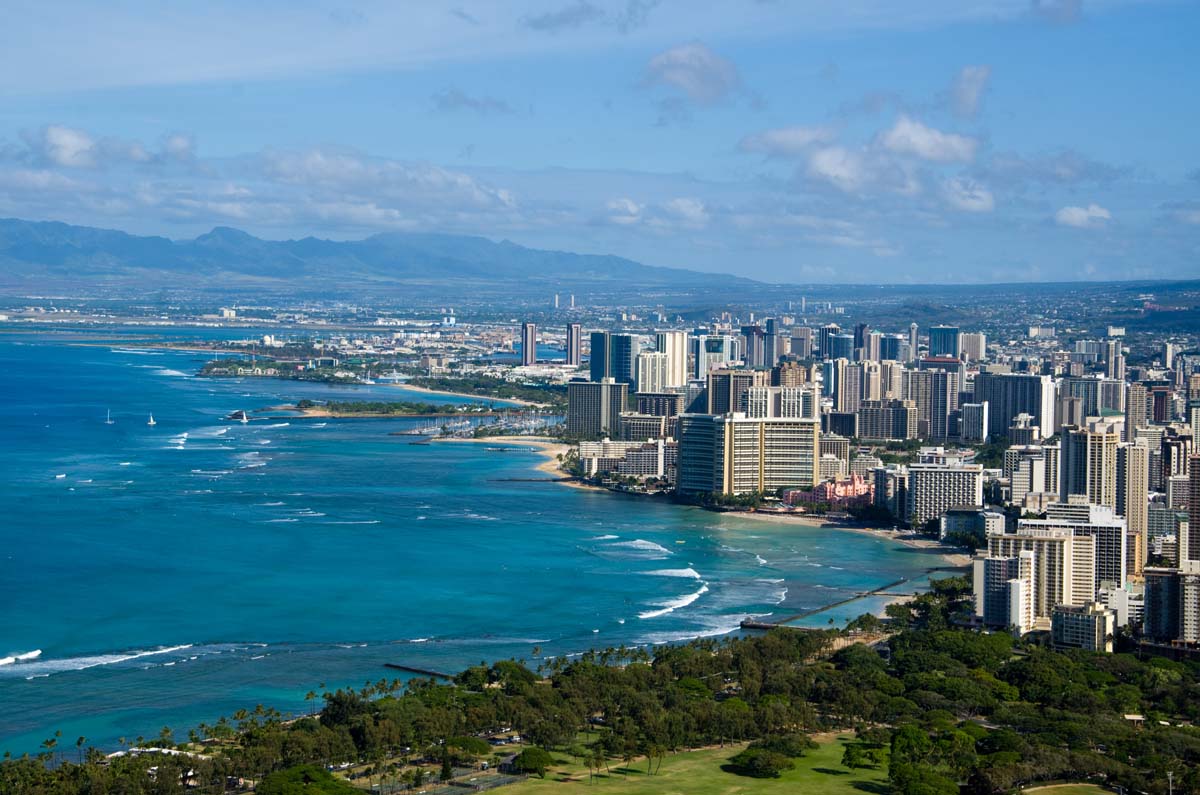
Honolulu (/ˌhɒnəˈluːluː/;[6] Hawaiian: [honoˈlulu]) is the capital and largest city of the U.S. state of Hawaii, which is located in the Pacific Ocean. It is an unincorporated county seat of the consolidated City and County of Honolulu, situated along the southeast coast of the island of Oʻahu,[a] and is the westernmost and southernmost major U.S. city. Honolulu is Hawaii's main gateway to the world. It is also a major hub for international business, finance, hospitality, and military defense in both the state and Oceania. The city is characterized by a mix of various Asian, Western, and Pacific cultures, as reflected in its diverse demography, cuisine, and traditions.
Honolulu means "sheltered harbor"[8] or "calm port" in Hawaiian;[9] its old name, Kou, roughly encompasses the area from Nuʻuanu Avenue to Alakea Street and from Hotel Street to Queen Street, which is the heart of the present downtown district.[10] The city's desirability as a port accounts for its historical growth and importance in the Hawaiian archipelago and the broader Pacific region. Honolulu has been the capital of the Hawaiian Islands since 1845, first of the independent Hawaiian Kingdom, and after 1898 of the U.S. territory and state of Hawaii. The city gained worldwide recognition following Japan's attack on nearby Pearl Harbor on December 7, 1941, which prompted decisive entry of the U.S. into World War II; the harbor remains a major naval base, hosting the U.S. Pacific Fleet, the world's largest naval command.[11]
As Hawaii is the only state with no incorporated places below the county level,[12] the U.S. Census Bureau recognizes the approximate area commonly referred to as the "City of Honolulu"—not to be confused with the "City and County"—as a census county division (CCD).[13] As of the 2020 U.S. Census, the population of Honolulu is 350,964,[14] while that of metropolitan Honolulu census-designated place (CDP) is 802,459.[15] With over 300,000 residents, Honolulu is the most populated Oceanian city outside Australasia.[16][17]
Honolulu's favorable tropical climate, rich natural scenery, and extensive beaches make it a popular global destination for tourists. As of May 2021, the city receives the bulk of visitors to Hawaii, between 7,000 and 11,000 daily. This is below the 2019, pre-pandemic, passenger arrivals of 10,000 to 15,000 per day.

Jacksonville is a city located on the Atlantic coast of Florida, the most populous city in the state, and is the largest city by area in the contiguous United States as of 2020.[6] It is the seat of Duval County,[7] with which the city government consolidated in 1968. Consolidation gave Jacksonville its great size and placed most of its metropolitan population within the city limits. As of 2020, Jacksonville's population is 949,611,[8] making it the 12th most populous city in the U.S., the most populous city in the Southeast, and the most populous city in the South outside of the state of Texas.[9] With a population of 1,733,937, the Jacksonville metropolitan area ranks as Florida's fourth-largest metropolitan region.[4]
Jacksonville straddles the St. Johns River in the First Coast region of northeast Florida, about 25 miles (40 km) south of the Georgia state line and 328 miles (528 km) north of Miami.[10] The Jacksonville Beaches communities are along the adjacent Atlantic coast. The area was originally inhabited by the Timucua people, and in 1564 was the site of the French colony of Fort Caroline, one of the earliest European settlements in what is now the continental United States. Under British rule, a settlement grew at the narrow point in the river where cattle crossed, known as Wacca Pilatka to the Seminole and the Cow Ford to the British. A platted town was established there in 1822, a year after the United States gained Florida from Spain; it was named after Andrew Jackson, the first military governor of the Florida Territory and seventh President of the United States.
Harbor improvements since the late 19th century have made Jacksonville a major military and civilian deep-water port. Its riverine location facilitates Naval Station Mayport, Naval Air Station Jacksonville, the U.S. Marine Corps Blount Island Command, and the Port of Jacksonville, Florida's third largest seaport.[11] Jacksonville's military bases and the nearby Naval Submarine Base Kings Bay form the third largest military presence in the United States.[12] Significant factors in the local economy include services such as banking, insurance, healthcare and logistics. As with much of Florida, tourism is important to the Jacksonville area, particularly tourism related to golf.[13][14] People from Jacksonville are sometimes called "Jacksonvillians" or "Jaxsons" (also spelled "Jaxons").
 England
England

 International cities
International cities
 *European Capital of Culture
*European Capital of Culture
 Silk road
Silk road
 United Kingdom
United Kingdom

 World Heritage
World Heritage

 Important port
Important port
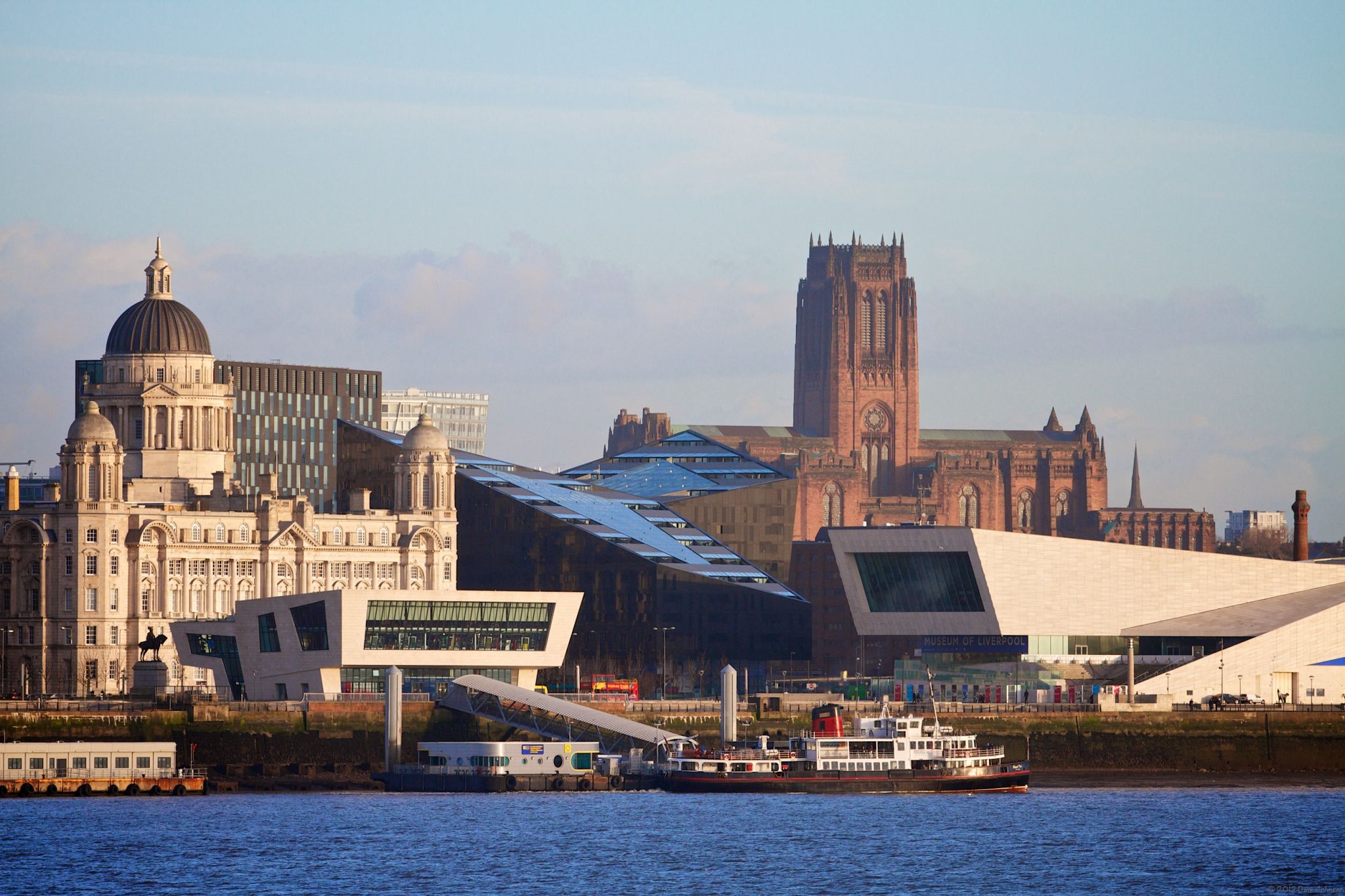
Liverpool (/ˈlɪvərpuːl/) is a city in North West England, with an estimated population of 491,500 in 2017.[5] Its metropolitan area is the fifth-largest in the UK, with a population of 2.24 million in 2011.[6] The local authority is Liverpool City Council, the most populous local government district in the metropolitan county of Merseyside and the largest in the Liverpool City Region.
Liverpool is on the eastern side of the Mersey Estuary, and historically lay within the ancient hundred of West Derby in the south west of the county of Lancashire.[7][8] It became a borough in 1207 and a city in 1880. In 1889, it became a county borough independent of Lancashire. Its growth as a major port was paralleled by the expansion of the city throughout the Industrial Revolution. Along with handling general cargo, freight, raw materials such as coal and cotton, the city merchants were involved in the Atlantic slave trade. In the 19th century, it was a major port of departure for Irish and English emigrants to North America. Liverpool was home to both the Cunard and White Star Line, and was the port of registry of the ocean liner RMS Titanic, the RMS Lusitania, RMS Queen Mary and RMS Olympic.
The popularity of the Beatles and other groups from the Merseybeat era contributes to Liverpool's status as a tourist destination. Liverpool is also the home of two Premier League football clubs, Liverpool and Everton, matches between the two being known as the Merseyside derby. The Grand National horse race takes place annually at Aintree Racecourse on the outskirts of the city.
The city celebrated its 800th anniversary in 2007. In 2008, it was nominated as the annual European Capital of Culture together with Stavanger, Norway.[9] Several areas of the city centre were granted World Heritage Site status by UNESCO in 2004. The Liverpool Maritime Mercantile City includes the Pier Head, Albert Dock, and William Brown Street.[10] Liverpool's status as a port city has attracted a diverse population, which, historically, was drawn from a wide range of peoples, cultures, and religions, particularly from Ireland and Wales. The city is also home to the oldest Black African community in the country and the oldest Chinese community in Europe.
Natives and residents of the city of Liverpool are referred to as Liverpudlians, and colloquially as "Scousers", a reference to "scouse", a form of stew. The word "Scouse" has also become synonymous with the Liverpool accent and dialect.

 Architecture
Architecture
 England
England
 Eurovision Song Contest,ESC
Eurovision Song Contest,ESC

 Financial
Financial
 ***Global Financial Center
***Global Financial Center
 UEFA European Championship 2020
UEFA European Championship 2020

 History
History
 N 2000 - 2100 AD
N 2000 - 2100 AD

 History
History
 M 1500 - 2000 AD
M 1500 - 2000 AD

 History
History
 J 0 - 500 AD
J 0 - 500 AD

 History
History
 K 500 - 1000 AD
K 500 - 1000 AD

 History
History
 L 1000 - 1500 AD
L 1000 - 1500 AD

 International cities
International cities
 ***Global Urban Economic Competitiveness
***Global Urban Economic Competitiveness
 ITU World Championship Series
ITU World Championship Series

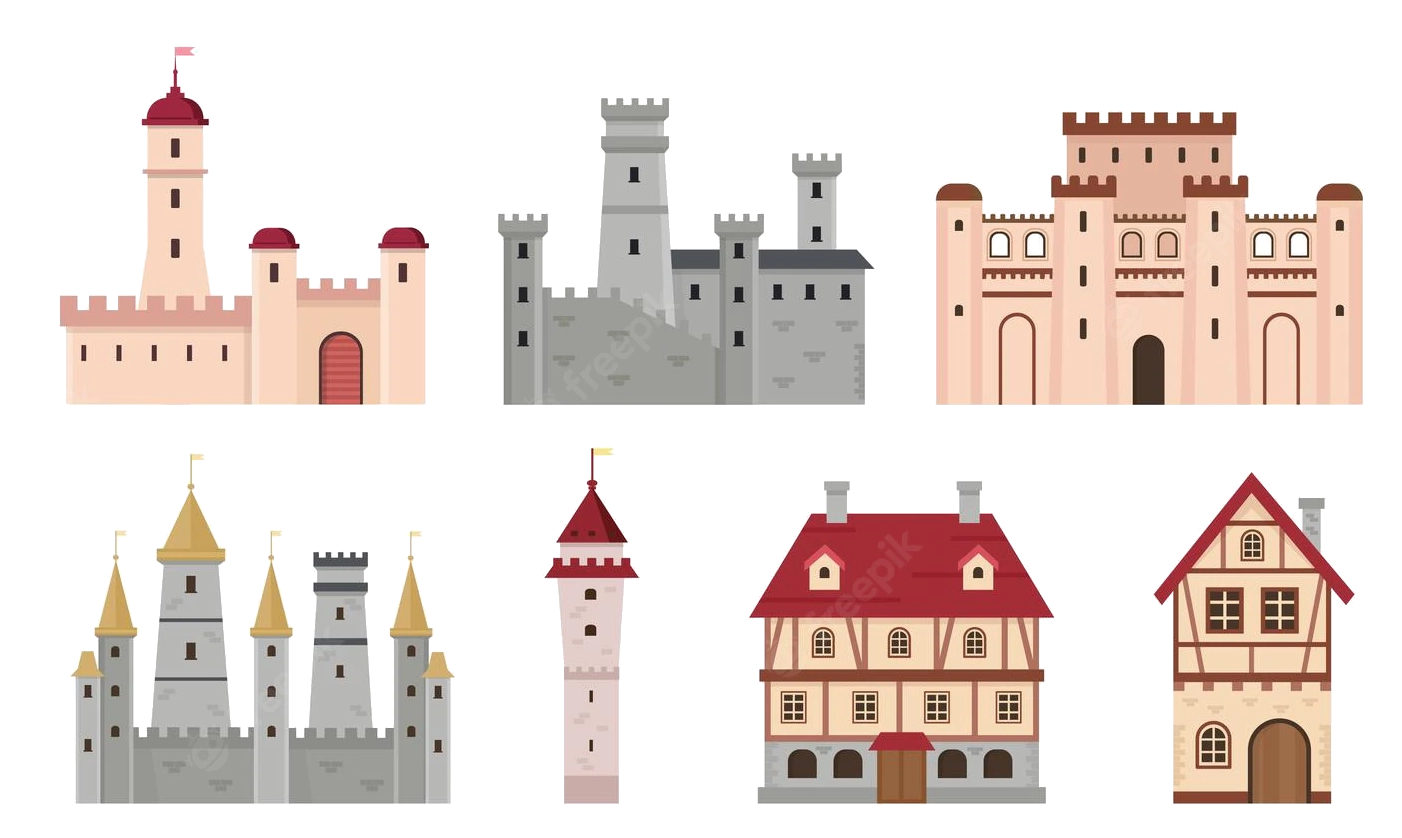 Medieval cities in Europe
Medieval cities in Europe
 Olympic Summer Games
Olympic Summer Games
 1908 Summer Olympics
1908 Summer Olympics
 1944 Summer Olympics
1944 Summer Olympics
 1948 Summer Olympics
1948 Summer Olympics
 2012 Summer Olympics
2012 Summer Olympics
 Silk road
Silk road

 Sport
Sport

 Sport
Sport
 Triathlon
Triathlon
 United Kingdom
United Kingdom

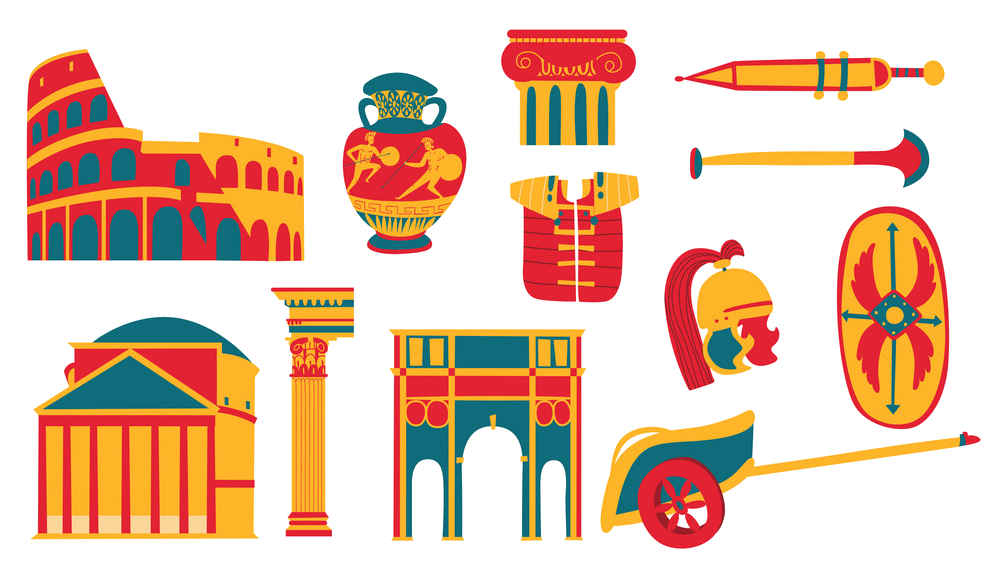 Cities founded by the Romans
Cities founded by the Romans

 World Heritage
World Heritage

 Important port
Important port
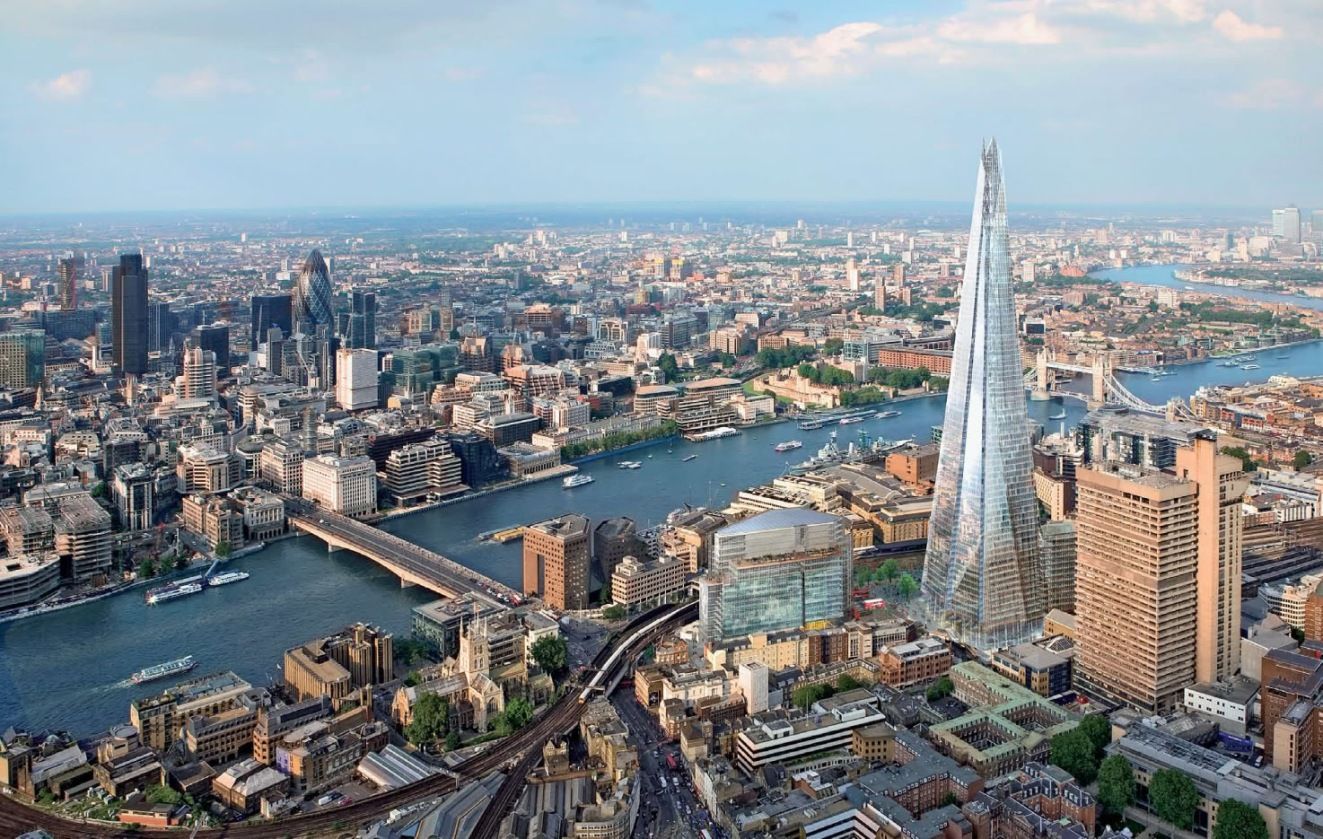
London (/ˈlʌndən/ ( listen) LUN-dən) is the capital and most populous city of England and the United Kingdom.[8][9] Standing on the River Thames in the south east of the island of Great Britain, London has been a major settlement for two millennia. It was founded by the Romans, who named it Londinium.[10] London's ancient core, the City of London, largely retains its 1.12-square-mile (2.9 km2) medieval boundaries. Since at least the 19th century, "London" has also referred to the metropolis around this core, historically split between Middlesex, Essex, Surrey, Kent and Hertfordshire,[11][12][13] which today largely makes up Greater London,[14][15][note 1] a region governed by the Mayor of London and the London Assembly.[16][note 2][17]
listen) LUN-dən) is the capital and most populous city of England and the United Kingdom.[8][9] Standing on the River Thames in the south east of the island of Great Britain, London has been a major settlement for two millennia. It was founded by the Romans, who named it Londinium.[10] London's ancient core, the City of London, largely retains its 1.12-square-mile (2.9 km2) medieval boundaries. Since at least the 19th century, "London" has also referred to the metropolis around this core, historically split between Middlesex, Essex, Surrey, Kent and Hertfordshire,[11][12][13] which today largely makes up Greater London,[14][15][note 1] a region governed by the Mayor of London and the London Assembly.[16][note 2][17]
London is one of the leading global cities[18][19] in the arts, commerce, education, entertainment, fashion, finance, healthcare, media, professional services, research and development, tourism and transportation.[20][21][22] It is the world's largest financial centre[23][24][25][26] and has the fifth or sixth largest metropolitan area GDP in the world.[note 3][27][28] London is often regarded as a world cultural capital.[29][30][31] It is the world's most-visited city as measured by international arrivals[32] and has the world's largest city airport system measured by passenger traffic.[33] It is the world's leading investment destination,[34][35][36][37] hosting more international retailers[38][39] and ultra high-net-worth individuals[40][41] than any other city. London's universities form the largest concentration of higher education institutes in Europe.[42] In 2012, London became the first city to have hosted the modern Summer Olympic Games three times.[43]
London has a diverse range of people and cultures, and more than 300 languages are spoken in the region.[44] Its estimated mid-2016 municipal population (corresponding to Greater London) was 8,787,892,[4] the largest of any city in the European Union[45] and accounting for 13.4% of the UK population.[46] London's urban area is the second most populous in the EU, after Paris, with 9,787,426 inhabitants at the 2011 census.[47] The city's metropolitan area is the most populous in the EU with 14,040,163 inhabitants in 2016,[note 4][3] while the Greater London Authority states the population of the city-region (covering a large part of the south east) as 22.7 million.[48][49] London was the world's most populous city from around 1831 to 1925.[50]
London contains four World Heritage Sites: the Tower of London; Kew Gardens; the site comprising the Palace of Westminster, Westminster Abbey, and St Margaret's Church; and the historic settlement of Greenwich (in which the Royal Observatory, Greenwich defines the Prime Meridian, 0° longitude, and GMT).[51] Other landmarks include Buckingham Palace, the London Eye, Piccadilly Circus, St Paul's Cathedral, Tower Bridge, Trafalgar Square and The Shard. London is home to numerous museums, galleries, libraries, sporting events and other cultural institutions, including the British Museum, National Gallery, Natural History Museum, Tate Modern, British Library and West End theatres.[52] The London Underground is the oldest underground railway network in the world.
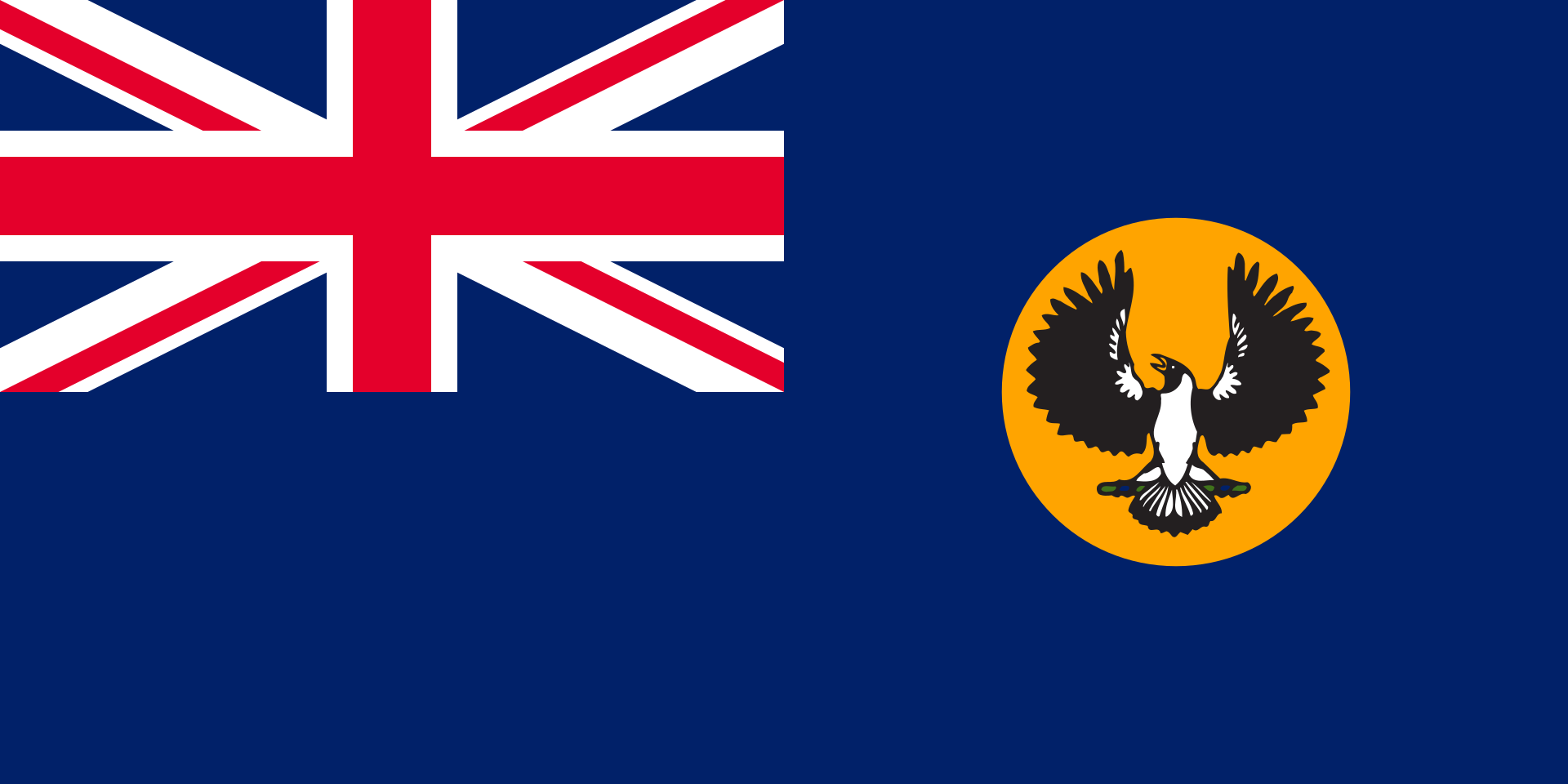 South Australia-SA
South Australia-SA
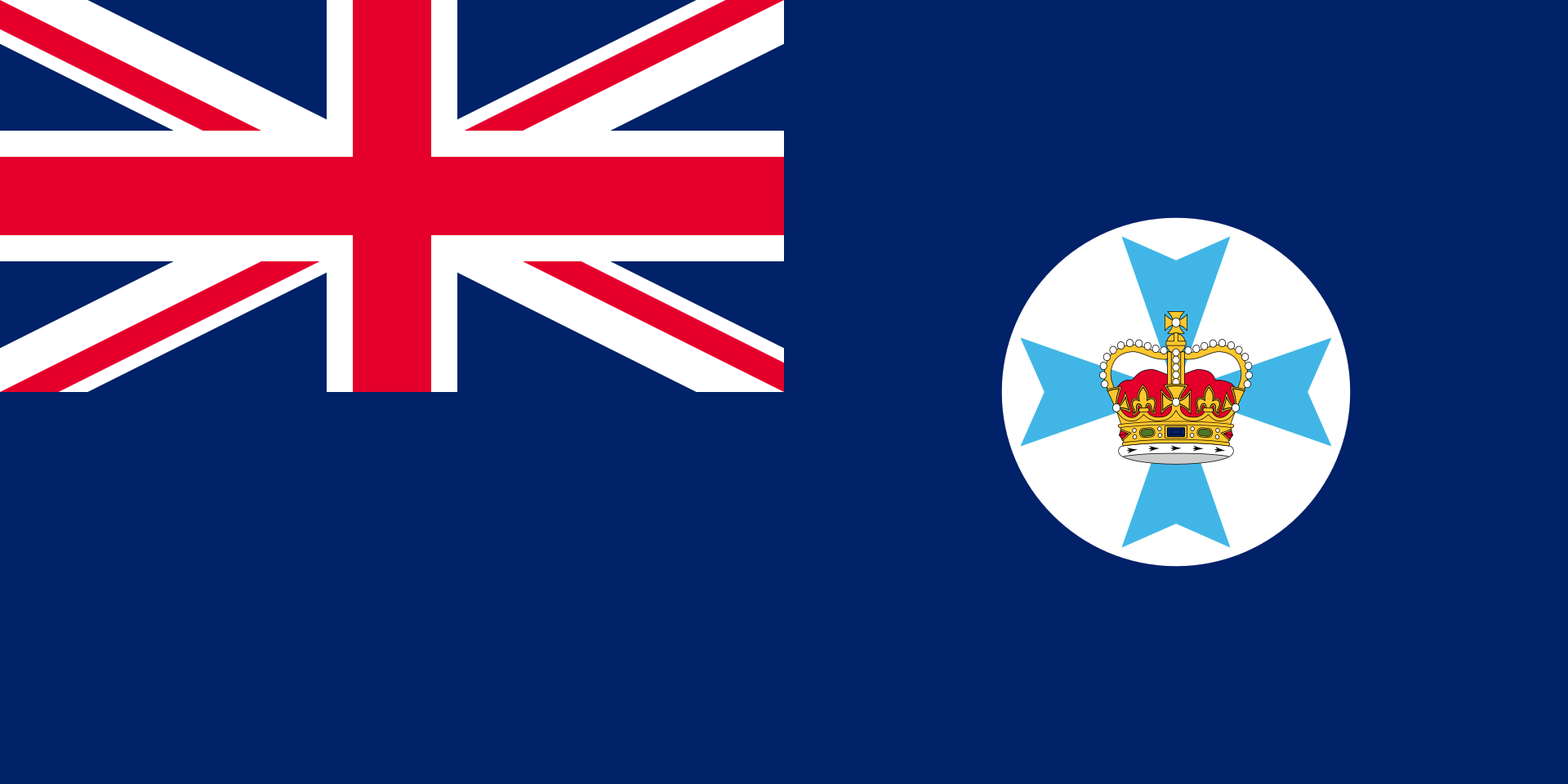 Queensland-QLD
Queensland-QLD
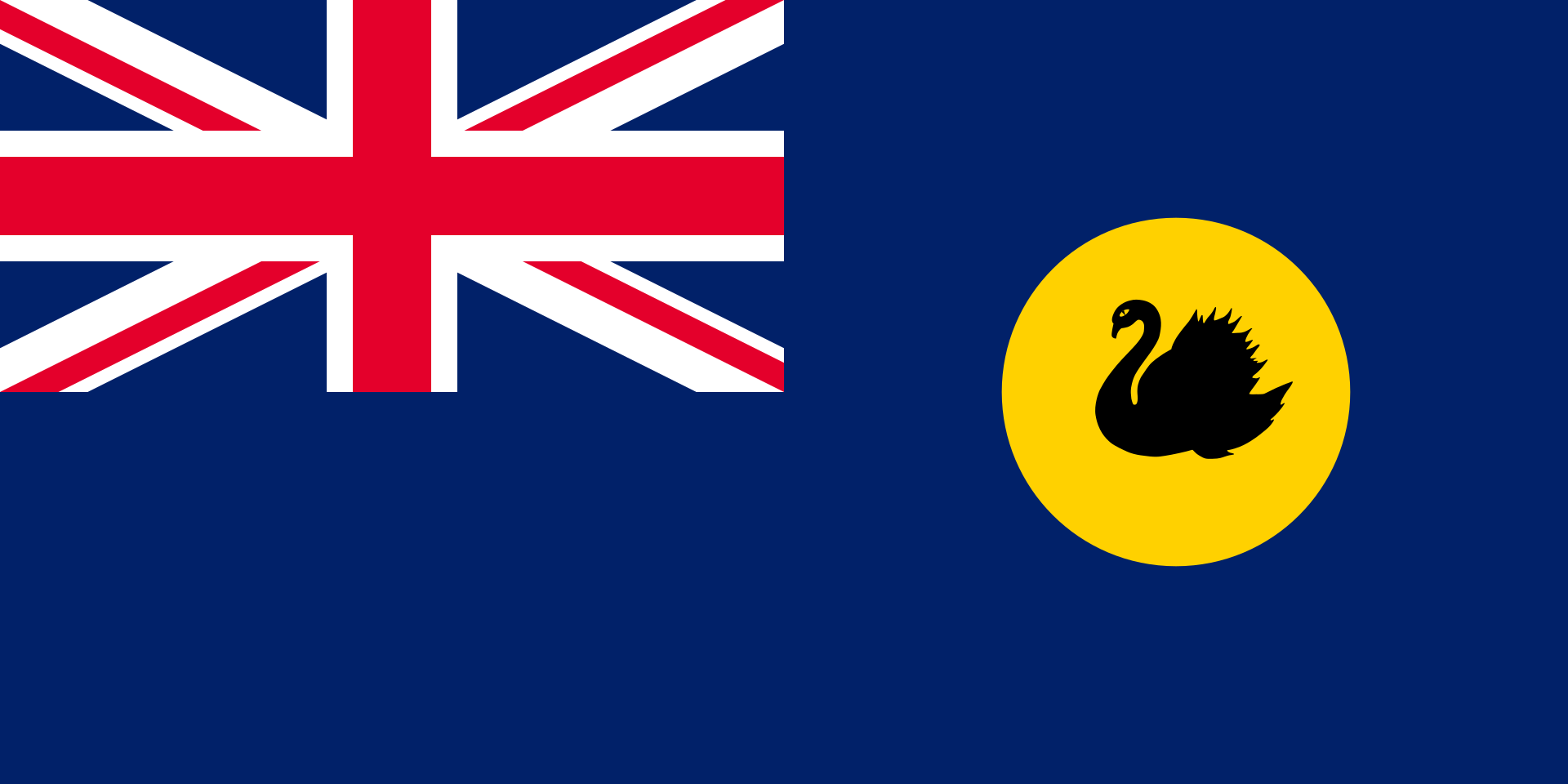 Western Australia-WA
Western Australia-WA
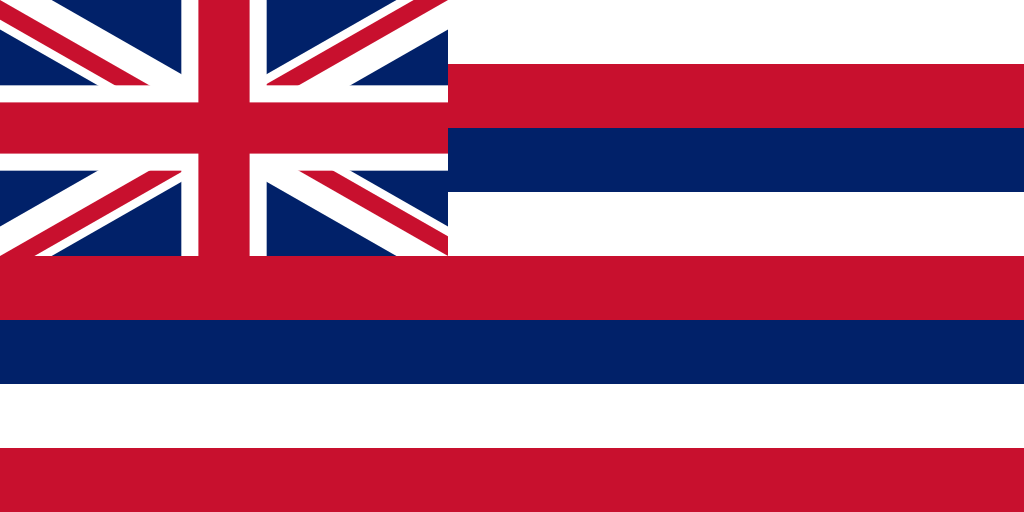 Hawaii-HI
Hawaii-HI
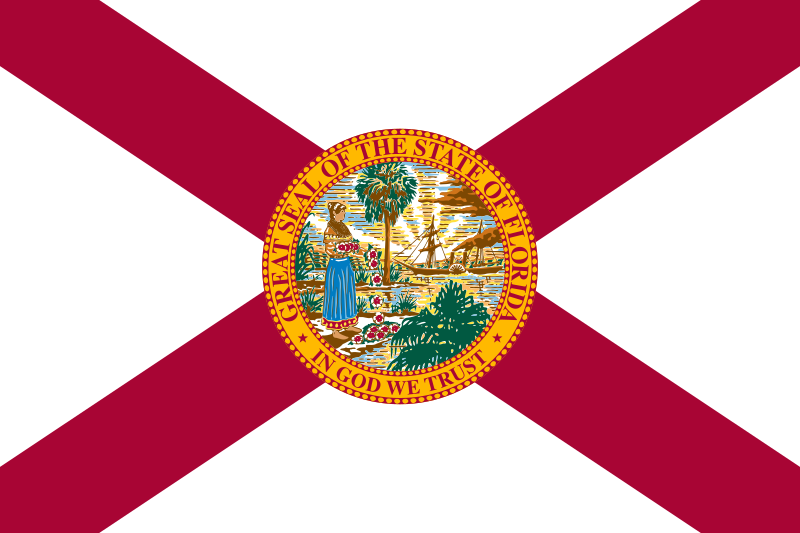 Florida-FL
Florida-FL